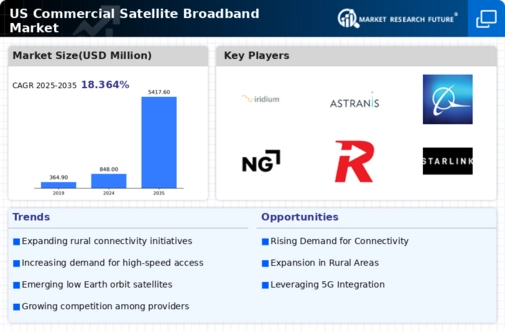Expansion of IoT Applications
The proliferation of Internet of Things (IoT) devices is significantly influencing the commercial satellite-broadband market. As industries adopt IoT technologies for automation and data collection, the need for reliable connectivity becomes paramount. In the US, it is estimated that the number of connected IoT devices will reach over 30 billion by 2025, creating a substantial demand for satellite broadband services. These services are particularly valuable in sectors such as agriculture, transportation, and energy, where remote monitoring and control are essential. The commercial satellite-broadband market is likely to benefit from this trend, as it offers the necessary infrastructure to support the vast network of IoT devices, ensuring seamless communication and data transfer across various applications.
Growing Focus on Rural Connectivity
The push for improved connectivity in rural areas is a vital driver for the commercial satellite-broadband market. Many rural communities in the US still lack access to reliable internet services, which hampers economic development and access to essential services. Government initiatives and private sector efforts are increasingly focused on bridging this digital divide. In 2025, it is anticipated that funding for rural broadband initiatives will reach approximately $5 billion, aimed at expanding satellite broadband services to underserved regions. This focus on rural connectivity is likely to stimulate growth in the commercial satellite-broadband market, as providers seek to deliver solutions that cater to these areas, ultimately enhancing the quality of life for residents.
Rising Demand for High-Speed Internet
The increasing demand for high-speed internet access across various sectors is a primary driver for the commercial satellite-broadband market. Businesses, educational institutions, and healthcare facilities are seeking reliable and fast internet solutions to support their operations. According to recent data, approximately 30% of businesses in the US have reported a need for enhanced connectivity to facilitate remote work and digital services. This trend is likely to continue, as more organizations recognize the importance of robust internet infrastructure. The commercial satellite-broadband market is positioned to meet this demand, providing services that can reach remote and underserved areas where traditional broadband options are limited. As a result, the market is expected to experience significant growth, driven by the necessity for high-speed internet in an increasingly digital economy.
Emerging Applications in Disaster Recovery
The commercial satellite-broadband market is also being driven by the growing recognition of satellite technology's role in disaster recovery and emergency response. In the face of natural disasters, traditional communication infrastructure often fails, highlighting the need for resilient and reliable alternatives. Satellite broadband can provide immediate connectivity in affected areas, facilitating communication for emergency services and relief efforts. As awareness of this capability increases, it is expected that investments in satellite solutions for disaster recovery will rise. By 2025, the market may see a surge in demand for satellite broadband services specifically tailored for emergency situations, further solidifying its importance in the overall telecommunications landscape.
Increased Investment in Satellite Infrastructure
Investment in satellite infrastructure is a crucial driver for the commercial satellite-broadband market. With advancements in satellite technology, companies are allocating significant resources to enhance their satellite networks. In 2025, it is projected that investments in satellite broadband infrastructure in the US will exceed $10 billion, reflecting a growing commitment to improving connectivity. This influx of capital is likely to lead to the deployment of more satellites, which can provide higher bandwidth and lower latency services. As a result, the commercial satellite-broadband market is expected to expand, offering improved service quality and coverage to meet the evolving needs of consumers and businesses alike.






















Leave a Comment